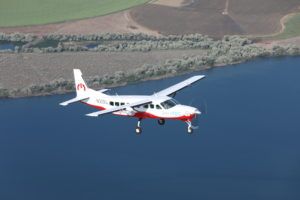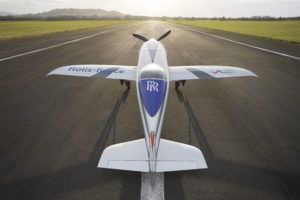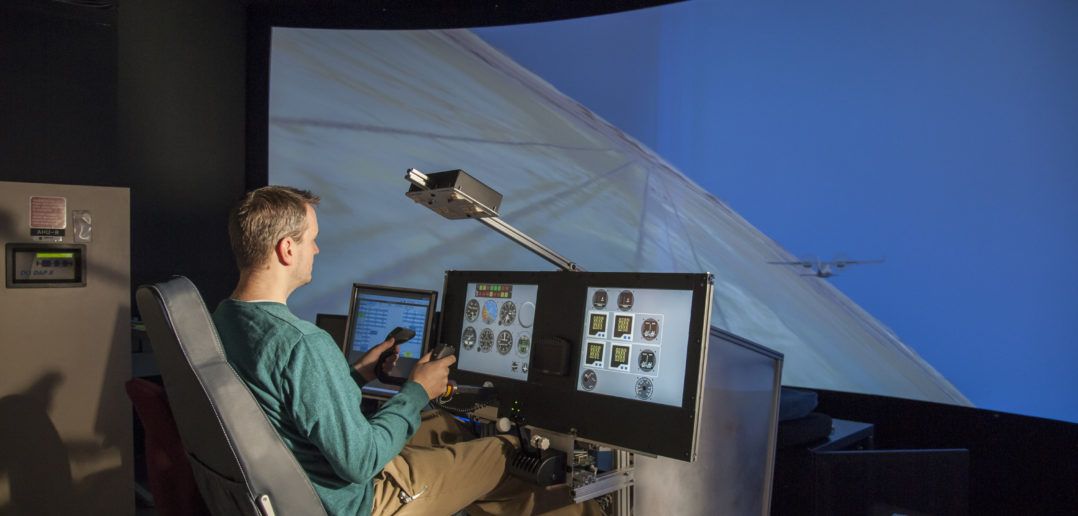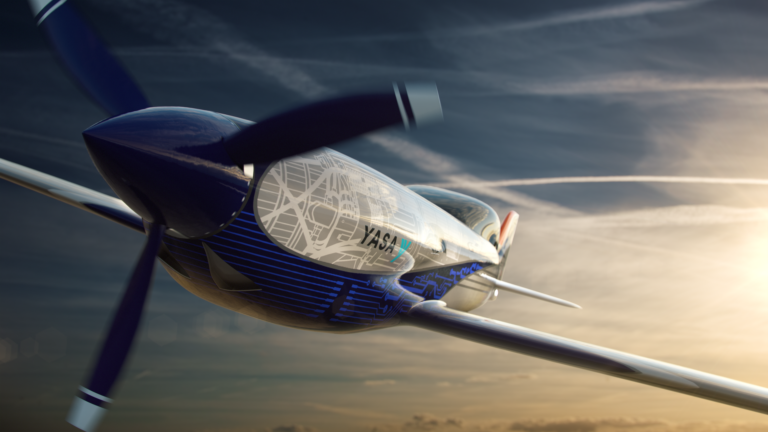Words by Paul Willis
Within the last year there have been several important milestones in battery-powered electric flight.
Last May at an airfield in Washington State the eCaravan, a nine-seater Cessna Caravan retrofitted with an electric powertrain made history as the largest electric airplane ever to fly. In March 2021 the Spirit of Innovation, a high-performance battery-powered aircraft developed by Rolls-Royce, was powered up before a planned bid to set a new world speed record for
all-electric flight.
NASA is currently ground testing the powertrain of its first all-electric X-Plane, the X-57 Maxwell and development of Eviation’s Alice all-electric aircraft is ongoing. It’s an exciting time to be working in aviation, says Lee Human, the founder and CEO of AeroTEC, the aerospace company which oversaw the testing, engineering, and certification of the eCaravan.
“Honestly, this is a great time to be in aerospace,” says Human. “We haven’t had a revolution in propulsion systems and new technologies of this magnitude since the early days of jet aircraft some 60 to 70 years ago.”
Energy Density

While the development of aircraft like the eCaravan, the Spirit of Innovation and the Alice hold out the tantalizing possibility of commercial electric flight in the near future, perhaps before the end of the current decade, it is important not to get too carried away with these successes.
Duncan Walker, a reader in applied aerodynamics at Loughborough University says, “The flight of the eCaravan is a significant achievement in that it successfully demonstrated the use of a fully electric drivetrain.
“However, both the eCaravan and Alice are small aircraft. Alice is designed to carry just nine passengers and the eCaravan carried only the pilot with all the passenger seats replaced by batteries.
“Current battery technology simply can’t store the huge amount of energy that is required to power larger aircraft over practical distances.”
The reason for this is energy density, which is a measure of the amount of energy that can be stored in a system compared to its size. Aviation fuels such as kerosene have a very high energy density of about 12,000Wh/kg. But a lithium-ion battery’s energy density is just 250Wh/kg. For context, if Airbus wanted to electrify the A380 and keep its current range of 15,000km (9,300 miles) it would need batteries weighing as much as 30 times more than its current fuel load, “it would never get off the ground”, says Walker.
Given these fundamental challenges the success of the flagship projects mentioned above appears even more impressive.
Matheu Parr, project manager for Accelerating the Electrification of Flight (ACCEL), the Rolls-Royce-led research program behind the Spirit of Innovation, identifies three key challenges in the aircraft’s development.
“ACCEL aims to integrate an electric powertrain to propel our aircraft to more than 300mph (480km/h), design and build a battery that can both hold enough energy to complete the record run and is still lightweight enough for the airplane and thirdly, manage all of this incredible innovation in a safe and airworthy manner,” Parr says.
Safety

A crucial part of ACCEL like all electric aircraft testing programs is safety, because of the massive voltages involved in working with electric aircraft.
“When you’re laying out a test program you have your data requirements, but very quickly you will come to your test hazard assessments,” says Human. “There was no reference material for these hazards when we did the eCaravan because we were breaking new ground.”
As a result, Human and his team took “very cautious steps” to develop the procedures and safety measures needed for conducting safe ground testing with up to 700 volts during the development of Eviation’s Alice.
These measures included training team members on how to safely handle the high voltage electrical systems involved with the research program. Failsafes such as padlocks on switches to ensure the batteries could not be accidentally switched on were also put
in place.
The failsafes are especially important because unlike conventional turbine engines, “electric motors can go from zero to full RPM in a millisecond”, says Human.
“From a safety perspective, you need to ensure the aircraft can’t suddenly come to life in the hangar,” he adds.
For Alice’s flight tests another important safety concern that came to light was thermal management.
“In electric propulsion everything gets hot,” says Human. “Whether it’s the motor itself, the controllers or the batteries. There’s a lot of energy there and you’ve got to find a way of dissipating that energy because not all of it goes to the propeller.
“As an example, even managing the cabin temperature was something for which we needed a special procedure.”
Another concern is the possibility of an arc flash, when an electric current jumps through the air from one wire to another because the insulation or isolation on the wiring is insufficient to withstand the applied voltage.
There is a higher risk of this happening in aircraft because “as you increase altitude the air density goes down,” says Human. To counter this risk the electric propulsion systems had to be designed “with the wiring spaced apart”.
The eCaravan’s electric propulsion system was supplied by Washington State, USA-based electric motor manufacturer magniX. With the latest testing phase of the eCaravan complete, magniX is working on certifying the propulsion system, a process which Human says should be done within a year.
Further developments will then consider the use of batteries with a higher energy density. Once that is achieved, a retrofit electric propulsion system can be brought to the market.
X-57

In contrast, NASA’s X-57 program is purely research driven and does not have the goal of creating a product for market. The X-57 program is being run at NASA’s Armstrong Flight Research Center in Edwards, California and at the time of writing is currently in its second phase.
The first phase, called Modification 1 (Mod 1), was a data gathering process where researchers rented a twin-engine Tecnam P2006T light aircraft.
Sean Clarke, the X-57 project’s principal investigator says, “We instrumented it and had our pilots conduct several flights at NASA Armstrong. We collected performance, handling and qualities data and then used that to build up our flight simulation for our models.
“For the current Mod 2 phase of testing, our electric propulsion system has been installed in place of the Rotax engines and our battery system installed in place of the fuel tanks.”
For the final two modifications, Mods 3 and 4, the aircraft will be fitted with a wing design which includes 12 small
high-lift motors integrated into the structure of the wing itself. Like the eCaravan, the X-57 team has developed safety features that take account of the hazards of electricity.
One is a switch that allows the aircraft’s traction system to be turned off externally. This was added says Clarke, for the benefit of first responders. “If we have a hard landing and first responders are deployed to the aircraft, we need them to be able to turn off the traction system without having to crawl into the cockpit to do that,” he says.
Clarke says that he and his team were initially “agnostic” about the type of zero-emission power they would use for the X-57’s propulsion system and decided on lithium batteries because it seemed the approach with the least risk.
“But the batteries weren’t as mature as they looked on paper and integrating them into the aircraft turned out to need a lot of engineering,” says Clarke.
To integrate the batteries the research team called on the knowledge of engineers in NASA’s space program, where the use of lithium batteries has been common practice for some time.
“We were able to pull in expertise from our space station colleagues over at Johnson and Glenn Research Centers,” says Clarke. “So we were able to leverage the same design techniques that
the International Space Station’s battery packs use.”
The initial goal of the X-57 project, says Clarke, was to “demonstrate radical increase in aircraft performance based on this propulsion airframe integration.”
While that is still one of its goals, as the project has developed it has become clear to Clarke and his colleagues that the larger significance of the project has been its role in guiding the work of the agencies creating the new standards and certification regime for electric aircraft.
“The most valuable outcome so far has been sharing the lessons learned for integrating these electrical systems,” says Clarke. “We participate in committees with standards agencies such as SAE International and ASTM International, ensuring that our test results, lessons and challenges are working their way into the standards development processes.
“We also work closely with the FAA and to a lesser extent with EASA and other civil aviation authorities located around the world.”
NASA’s contribution to the development of standards is extremely important not least because at present much of “the framework for certification is not in place,” says Human. “The truth is the technology is ahead of the regulatory bodies, which are playing catch up at this point,” says Human.
That being said, regulators are not dragging their feet on the issue, believes Human. “The FAA, for example, has a dedicated branch working on this which has been very supportive and forward thinking,” he adds.





